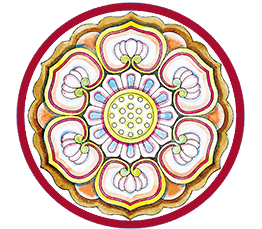Buddhism Q&A (2)
By Householder Fo'en
Q6: Was Shakyamuni Buddha a real person in history?
A: Yes. He is mentioned in history textbooks. "Shakya" means "competence and benevolence," and "muni" means "serenity." "Shakyamuni" refers to a sage of the Sakya clan. Shakyamuni Buddha lived around the 6th century B.C.E., equivalent to the Spring and Autumn period in China, and was a contemporary of Confucius. He was crown prince of the Kapilavastu kingdom in ancient India. His name was Gautama Siddhartha. His father was named Suddhodana; his mother, Maya. Queen Maya gave birth to Prince Siddhartha while taking a rest under a tree in Lumbini Grove. She died soon after giving birth. Prince Siddhartha was raised by his aunt Princess Prajapati.
Q7: Did he succeed to the throne?
A: No, he didn't. Since Prince Siddhartha was extremely wise and handsome, King Suddhodana expected him to be a chakravartin, or ideal universal ruler, who would subdue all nations. But Prince Siddhartha was strongly touched by the phenomena he observed: birth, aging, sickness and death, as well as the law of the jungle prevalent among living creatures. He meditated frequently and thought about taking monastic vows. Having discovered his son's intention, King Suddhodana tried his best to stop him. He arranged for his son to marry Princess Yasodhara from a neighboring state. Yasodhara bore him a son named Rahula. But all this was in vain. Finally Siddhartha slipped out of the royal palace in the still of the night and became a wandering mendicant seeking the truth.
Q8: So, we have to be a monk to study Buddhism?
A: Not necessarily. Shakyamuni Buddha later taught people a way to achieve full liberation without renunciation. It is to recite the name of Amitabha Buddha, gain rebirth in the Pure Land and attain Buddhahood there.
Q9: How did Prince Siddhartha become a Buddha?
A: After leaving home, he visited three renowned scholars of the day and learned from them. Very soon, he mastered all their methods. But none of them was the real path of liberation. He then decided to seek freedom from samsara by himself. To convince the ascetics (who practiced austerities popular at the time), Siddhartha underwent severe austerities for six years in a forest on the banks of the Neranjara River, living on a grain of rice a day. After realizing the futility of austerities in his search for enlightenment, Siddhartha stopped them and took a bath in the Neranjara River, cleaning off the accumulated dirt of six years. He accepted milk gruel offered by a shepherd girl and recovered his strength. Then he went to a pippala tree, sat down on a seat made from auspicious grass and faced East. He vowed, "I will not rise from this seat until I have attained supreme enlightenment!" Finally, one night, after defeating moral afflictions and Mara's temptations, he achieved complete enlightenment and became a Buddha.
The place where Shakyamuni attained Buddhahood is in the southern suburbs of Bodh Gaya in India's Bihar State. Nearby are numerous other sites associated with the Buddha.
Characteristics
- Recitation of Amitabha’s name, relying on his Fundamental Vow (the 18th)
- Rebirth of ordinary beings in the Pure Land’s Realm of Rewards
- Rebirth assured in the present lifetime
- Non-retrogression achieved in this lifetime

The 18th Vow of Amitabha Buddha
If, when I achieve Buddhahood, sentient beings of the ten directions who sincerely and joyfully entrust themselves to me, wish to be reborn in my land and recite my name, even ten times, should fail to be born there, may I not attain perfect enlightenment. Excepted are those who commit the five gravest transgressions or slander the correct Dharma.
Guiding Principles
Faith in, and acceptance of, Amitabha’s deliverance
Single-minded recitation of Amitabha’s name
Aspiration to rebirth in Amitabha’s Pure Land
Comprehensive deliverance of all sentient beings
